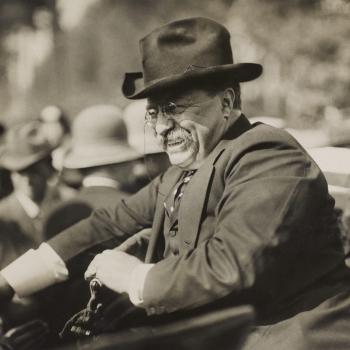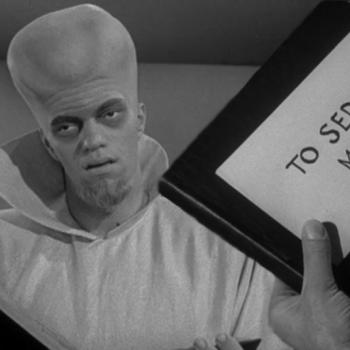If I had a dime for every article or post since 2016 by an evangelical who lamented the discrepancy between born-again Protestantism and Donald Trump, I might be able to retire. Peter Wehner, a long-time adviser and speech writer for Republican presidents (the inhumanity!) and a self-identified evangelical who has a new book on American politics, has a fairly recent article in the Atlantic and so owes me 10 cents. Evangelicalism is at a crossroads. The reason is Trump (it is that simple):
There’s a very high cost to our politics for celebrating the Trump style, but what is most personally painful to me as a person of the Christian faith is the cost to the Christian witness. Nonchalantly jettisoning the ethic of Jesus in favor of a political leader who embraces the ethic of Thrasymachus and Nietzsche—might makes right, the strong should rule over the weak, justice has no intrinsic worth, moral values are socially constructed and subjective—is troubling enough.
But there is also the undeniable hypocrisy of people who once made moral character, and especially sexual fidelity, central to their political calculus and who are now embracing a man of boundless corruptions. Don’t forget: Trump was essentially named an unindicted co-conspirator (“Individual 1”) in a scheme to make hush-money payments to a porn star who alleged she’d had an affair with him while he was married to his third wife, who had just given birth to their son.
Carl Henry may be a name unfamiliar to readers at Patheos and even to Wehner, but he was part of the evangelical establishment, such as it was when it formed after World War II around institutions like the National Association of Evangelicals, Fuller Seminary, and Christianity Today, and when it gained some notoriety from the celebrity of Billy Graham. In 1980, Henry wrote about the health of evangelicalism for the mainline Protestant (then) weekly magazine, Christian Century, and he was not optimistic.
What do the well-attended evangelical churches portend for the future? What will be the impact of their burgeoning colleges marked by life-changing vitality and moral earnestness? What of the vocal church memberships that now increasingly demand a voice in public affairs?
During the 1960s I somewhat romanced the possibility that a vast evangelical alliance might arise in the United States to coordinate effectively a national impact in evangelism, education, publication and sociopolitical action. Such an alliance is not the same thing as a new denomination. Quite apart from the question of its desirability, the remote possibility of such a national evangelical alliance was both shaped and lost, it seems to me, by evangelist Billy Graham. Penetrating the so-called mainline denominations with an evangelical rallying point, the Graham crusades reached far beyond the orbit of the National Association of Evangelicals. As the tide of enthusiasm for pluralistic ecumenism began to ebb, the prospect emerged for a mighty evangelical movement that transcended secondary denominational distinctions; it held in promise a transdenominational link involving Southern Baptists, the National Association of Evangelicals, Missouri Synod Lutherans, perhaps some associates of the American Council of Churches, and large numbers of disaffected evangelicals in ecumenically affiliated churches whom the NAE seemed unable to attract. Christianity Today became during my editorship (1956-68) an intellectual fulcrum for these overlapping evangelical concerns.
Graham is himself a Southern Baptist. Although he had the personal magnetism to rally and garner an umbrella alliance, he hesitated to do so. For his crusades he sought the fullest possible ecumenical backing, even if it often came grudgingly. To call for an evangelical countermovement that might penetrate ecumenical ranks would have eroded ecumenical support for the crusades. Graham was simultaneously under NAE pressures to extend that organization’s paraecumenical opportunities. By the early 1970s the prospect of a massive evangelical alliance seemed annually more remote, and by mid-decade it was gone.
Obstacles arose not simply because of denominational differences but also because of rival goals. Instead of uniting on something feasible, evangelicals too often backed away from the best option only to support nothing.
… In the ‘70s Christianity Today appealed more to lay readers and moved noticeably toward evangelical independency. The magazine gave only token support to Key ‘73, whose stimulus had come from an earlier editorial (“Somehow Let’s Get Together”). It viewed evangelical social action with high reservation, although the editor publicly indicated support of Nixon’s candidacy. Then, at the very time national newsmagazines spoke of “the year of the evangelical,” Christianity Today turned more inward than outward by channeling all theological issues into the inerrancy debate. The present staff strives to redress these misjudgments.
Many evangelical subgroups representing special interests stepped into this vacuum of missed evangelical opportunity. Magazines like Sojourners, the Other Side and the Reformed Journal took antiestablishment positions; divergent Calvinistic and Arminian groups sought a revitalized influence; evangelical social-action groups arose with varying emphases. Additional movements came to the fore: World Vision’s spectacular global ministry of evangelical humanitarianism; the charismatic phenomenon; the flourishing electronic church; the new core of Roman Catholic evangelicals; the Fuller Theological Seminary’s pro-ecumenical stance and alignment with critical views of the Bible; ecumenical alliances by left-wing evangelicals; politically right-wing groups like Moral Majority.
…Numerous crosscurrents now vex almost every effort at comprehensive evangelical liaison. At present no single leader or agency has the respect, magnetism or platform to summon all divergent elements to conference. Evangelical differences increasingly pose an identity crisis.
This article was published one day after the election of Ronald Reagan and a good generation before Donald Trump’s victory over Hillary Clinton.
Henry is by no means the last word or always accurate in assessing evangelicalism. He had some scars, some scores to settle thanks to the rivalries that had developed in the 1960s and 1970s at Fuller and Christianity Today. Even so, for Wehner (and other writers) to write as if evangelicalism was a unified movement with a solid reputation and coherent course of action either for the church or the nation is naive if not dishonest. In fact, evangelicals in the heartland may have tired of their fellow Christians with access to power in the District telling government officials and think tank audiences what evangelicalism “stood for.” A vote for Trump was a rejection of evangelical “leadership” and “representatives.” At the same time, what may have covered over the fundamental incoherence of evangelicalism was folks like Wehner whispering to elected officials that he or she could “count on” the support of born-again Protestants, as if these American believers agreed or evangelical leaders represented the people in the pew.
I cannot believe Wehner would describe the current crisis of evangelicalism the way he has if he had some awareness of born-again Protestantism’s history.












